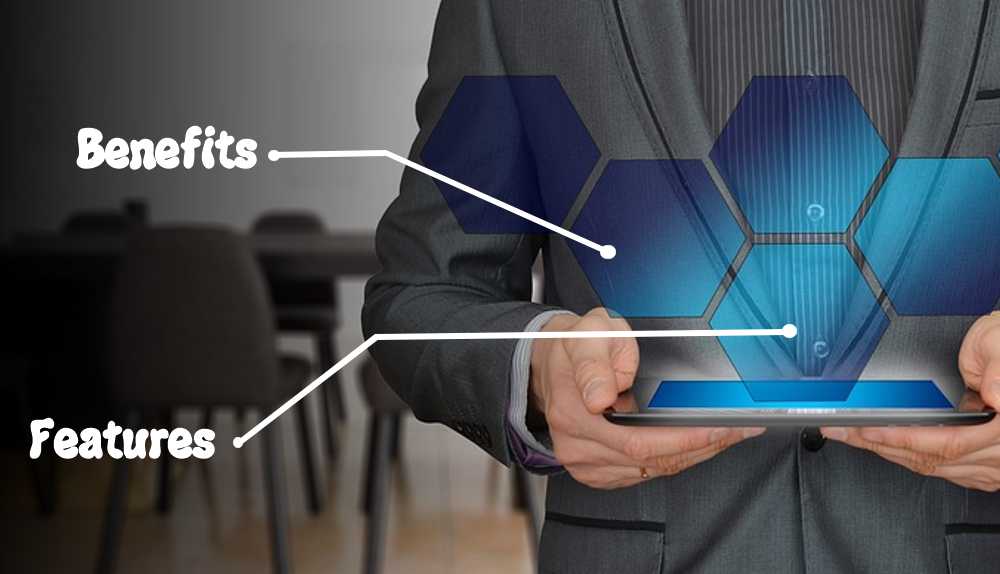Benefits vs Features: What Is The Difference?
In sales, it’s essential to focus on the benefits of a product or service rather than just its features. But it sometimes needs to be clarified where the line between the two lies. For example, is a product’s ability to scale with a customer’s growth a feature or a benefit? What about its top-quality materials or ease of use?
As a salesperson, it’s crucial to understand the difference between benefits vs features to convey the value of your offering to potential customers effectively. To succeed in sales, it’s essential to take a holistic approach and communicate all three elements to prospects.
Understanding this distinction can make all the difference in making a sale. Continue reading to learn all about the feature vs. benefits and why it matters.
What is The Difference Between Features vs. Benefits?

In this guide, you’ll learn the difference between features vs. benefits.
What is a benefit?
Benefits are the tangible or intangible outcomes customers experience when using a product or service. They are the driving force behind a customer’s decision to purchase, representing the value that the product or service brings to the customer.
Rather than simply wanting to buy things for the sake of owning them, consumers are typically motivated to solve a problem or fulfill a need. As such, benefits can be considered the primary reason a customer would choose to buy a particular product or service over others.
By highlighting the benefits of their offering, businesses can effectively communicate the value proposition to potential customers and convince them to purchase.
What is a feature?
A feature is a characteristic or function of a product or service. For software companies, features are typically software programs’ functionalities that allow users to perform specific tasks. Other product features might include a razor with multiple blades, a power drill with various interchangeable bits, or a refrigerator with the ability to produce crushed ice.
These features address common problems or needs of a company’s target market. While elements are essential for a product or service, they are not the primary reason customers purchase. Instead, customers are typically more motivated by a product or service’s benefits, such as solving a problem or fulfilling a need.
Benefit vs. Feature
Features and benefits are essential elements when marketing a product or service. While features describe the technical aspects of a product or service, outlining what it does and how it works, benefits focus on the positive impact a product or service can have on a customer’s life.
While both are valuable in the buyer’s journey, benefits are often more influential in convincing customers to purchase. Customers are typically more motivated by how a product or service can solve their problems or fulfill their needs rather than the technical details of how it works.
However, it is worth noting that features can sometimes be a deciding factor for customers in highly competitive markets. In these cases, it can be beneficial to highlight the unique features of your product or service and position them as a competitive advantage.
Ultimately, the most effective approach will depend on the specific market and the needs of your target audience. By carefully considering both features and benefits, businesses can effectively communicate the value of their offering and persuade potential customers to make a purchase.
Why are Benefits vs Features Often Confused?
One of the primary reasons businesses often struggle to differentiate between features and benefits is that they focus on their perspective and intentions rather than the customers. Marketers may spend a significant amount of time researching and analyzing the common issues experienced by the target audience, but this doesn’t necessarily mean that the benefits of their product or service are immediately apparent to customers.
It’s important to remember that most customers are primarily concerned with how a product or service will benefit them rather than the technical details of how it works or the effort that went into its development.
Another common mistake marketers make assuming that the time and effort invested in creating a new feature automatically translates to its importance to customers. In reality, most customers are primarily concerned with their own needs and desires and want to know how a product or service will benefit them personally.
This is why it’s essential to focus on the customer’s perspective and communicate the benefits of your offering rather than just listing features. By answering the question “What’s in it for me?” and focusing on the customer’s needs and desires, businesses can effectively communicate the value of their product or service and persuade potential customers to purchase.
Feature-Benefit Matrix
If you’re a marketer, you’ve probably heard of the saying “feature-benefit matrix.” While it may sound like another buzzword, these matrices are valuable tools for ensuring consistent, relevant, and accessible messaging for end-users.
A feature-benefit matrix is typically formatted as a grid, with one column of features, a few for benefits, and an extra column for specific data points. Using this format, you can quickly identify the unique benefits of your product’s features and simplify message mapping.
It also helps to ensure that all teams, including marketing and product, are on the exact same page regarding communication with end users. In short, feature-benefit matrices are a valuable tool for any marketer looking to communicate their product’s value to end-users effectively.
Conclusion
Understanding the difference between benefits vs features is crucial for sales success. While features describe the technical aspects of a product or service, benefits focus on the positive impact it can have on a customer’s life.
Customers are typically more motivated by how a product or service can solve their problems or fulfill their needs rather than the technical details of how it works. Businesses need to highlight the benefits of their offering to effectively communicate the value proposition to potential customers and convince them to purchase.
However, in highly competitive markets, highlighting unique features may also be necessary to position the product as a competitive advantage. By carefully considering both features and benefits, businesses can effectively communicate the value of their offering and persuade potential customers to make a purchase.











